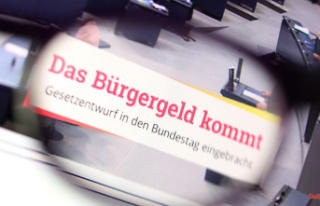The Bundestag is debating the new budget for 2023. For the first time, the traffic light coalition is solely responsible. Despite the debt brake, new debts are taken on. But that only succeeds because the SPD, Greens and FDP can use other special pots.
The federal budget for 2023 is the first budget that goes back solely to the coalition of SPD, Greens and FDP concluded a year ago. In the expenditure and income plan for the current year, the traffic light was able to set its own accents. But it built on the draft of the previous government.
For the first time in three budget years, Finance Minister Christian Lindner wants to comply with the debt brake prescribed by the Basic Law. It stipulates that the federal government may only take on new debts in the amount of up to 0.35 percent of economic output. According to the federal government, that would be exactly 12.606 billion euros for 2023. But new debt is expected to be almost four times as high in 2023. And yet the Minister of Finance can rightly claim that the debt brake is taking effect again. This is achieved through reserves, special pots and an economic trick that automatically relaxes the debt brake in economically difficult times.
The federal budget, which the Bundestag will pass on Friday, provides for expenditure of 476.3 billion euros. For this, the federal government is taking on new debts of 45.61 billion euros. The largest spending block is the Ministry of Labor and Social Affairs with 166.2 billion euros. Of this, more than 100 billion euros are earmarked for pension insurance alone, while 23.76 billion euros are planned for citizen benefits and 10.4 billion euros for the costs of accommodation for future recipients of citizen benefits. The next largest department is the Ministry of Defense with 50.1 billion euros.
This is followed by the digital and transport ministries (35.6 billion euros) and the health department (24.5 billion euros). The Ministry of Education and Research follows in fifth place with 21.5 billion euros, followed by the Ministry of Climate and Economics with 14.6 billion euros. The budget also covers relief for citizens and business in the tens of billions. These include the expansion of housing benefit and an increase in child benefit for all children to 250 euros per month. Likewise, higher basic tax allowances - but also the adjustment of the income tax rate to inflation with a calculated relief of 18.6 billion euros in the coming year alone.
The federal government wants to spend far more money than it takes in. Almost every eleventh euro is financed by planned new debts of 45.61 billion euros. This means that the net borrowing permitted under the debt brake is fully utilized except for a few million. Several special features allow this: In addition to the structural new debt of 12.606 billion euros permitted under the debt brake, there is a margin of a good 15.3 billion euros, because the gloomy economic outlook with a winter recession automatically gives the government more freedom to take economic countermeasures in the downturn.
In addition, there are almost 17.7 billion euros in so-called financial transactions that are financed by debt but are not counted towards the debt brake: These include ten billion euros for the build-up of a capital stock that is intended to generate returns through investments in the financial market, which from mid- of the 2030s should relieve the pension insurance. This goes back to the FDP, which speaks of a share pension.
However, the high level of new borrowing alone would not be enough to close the financial gap in the regular budget. To do this, Lindner also has to fall back on a cushion of 48.2 billion euros, which the previous governments had created from surpluses in the years 2015 to 2019 - the so-called asylum reserve, the purpose of which has been revoked. Around 40 billion euros of this will contribute in 2023 to ensuring that the debt brake can be adhered to mathematically.
But even the economic component of the debt brake and the asylum reserve alone would not have been enough to close the gap in the planned federal spending. The government uses other financial pots such as the Bundeswehr special fund and the climate and transformation fund (KTF) - above all from the 200 billion euro defense mechanism against the energy crisis. The main reason for this is the Ukraine war with its effects on energy prices. The government has estimated around 83.3 billion euros for 2023 for the planned energy price brakes for gas and electricity alone. This will not be financed from the budget, but from a new debt pot, which the traffic light has endowed with credit authorizations of 200 billion euros this year - although most of the expenditure will occur in 2023 and 2024.
The Federal Court of Auditors castigated this as borrowing for hoarding, which violates the constitutional principle that new borrowing should make up a deficit in the same year. The coalition remained unimpressed by the criticism. The special assets of the Bundeswehr, KTF and defense shield enable expenditures in the three-digit billion range outside of the regular budget in 2023.
Debts cost money - this also applies to the federal government, which had earned money with new debts during the zero interest rate policy of the European Central Bank (ECB) because the lenders accepted a discount. But with the ECB's rate hike course in the fight against record inflation, this is over. Even the burden of the old debts will almost explode if the calculations of the Ministry of Finance are correct: Almost 40 billion euros are estimated as interest burdens in 2023 and thus ten times the figure for 2021.
Budget politicians point out that previous finance ministers tended to overestimate the interest item in the planning in order to have reserves for unexpected expenses over the course of a year. They are therefore skeptical about the Finance Ministry's calculations for 2023. What is undisputed, however, is that the interest burden will increase drastically, probably also in the coming years. In addition, from 2028 there will be repayment for the record new debt taken up from 2020 to 2022.
The debt level of the federal government has increased by around 500 billion euros in these years, from 1011 billion euros in 2019 to probably over 1500 billion euros in the current year. That constricts future budgets. According to current calculations, over 30 years up to 2058, twelve billion euros will be due each year. The repayment of the loans for the 200 billion euro defense shield is not included. This is not scheduled to start until 2031.












